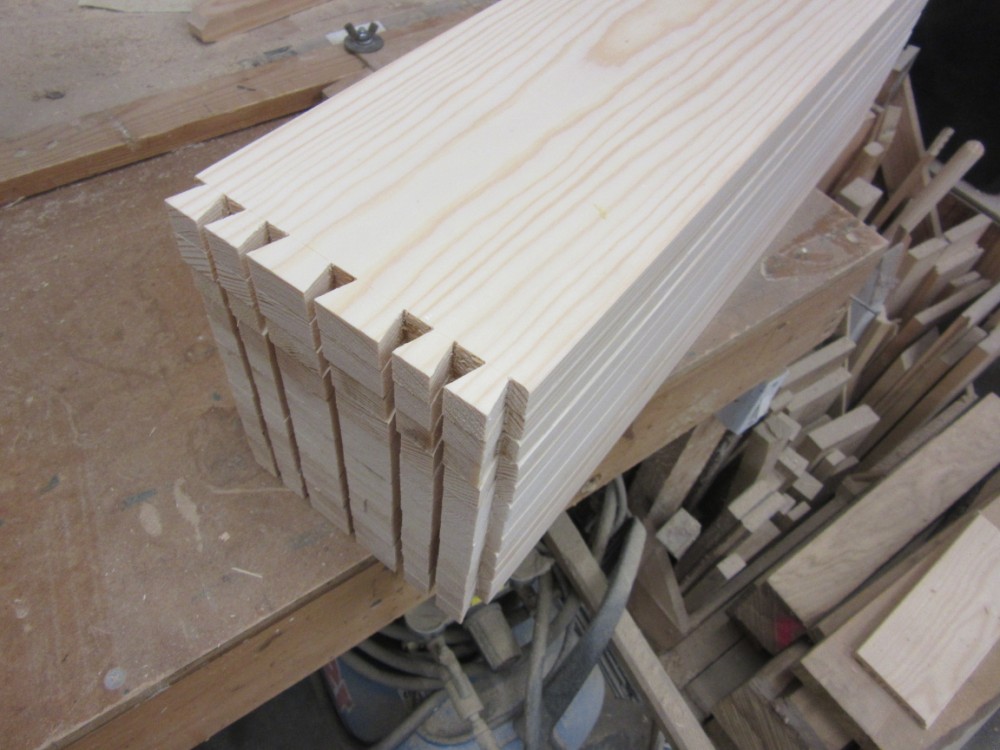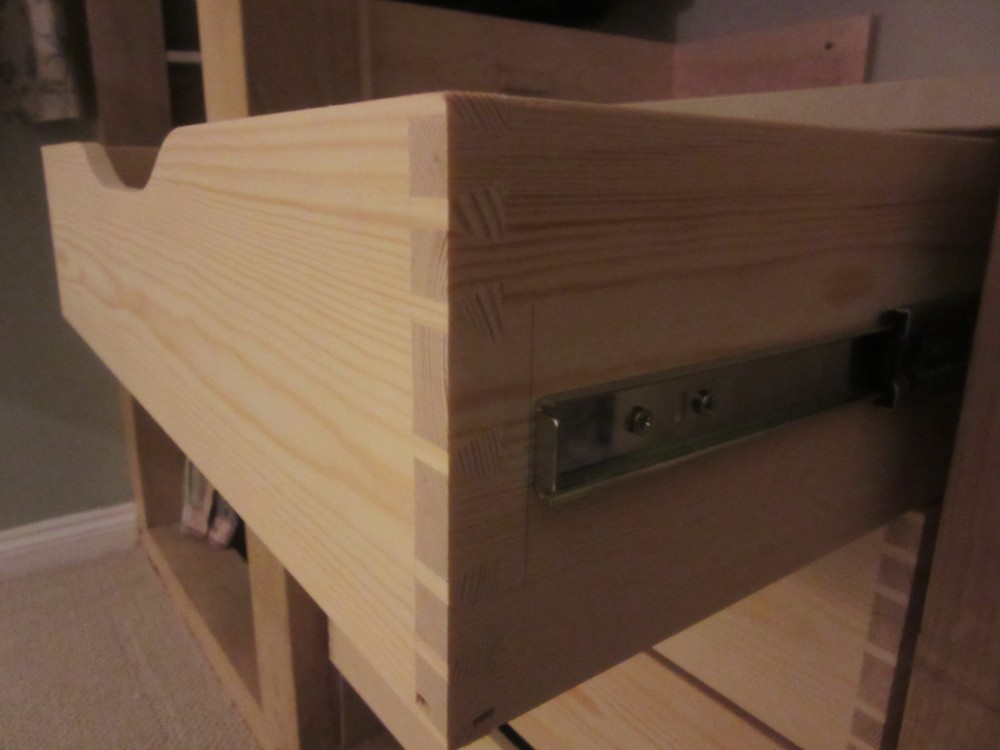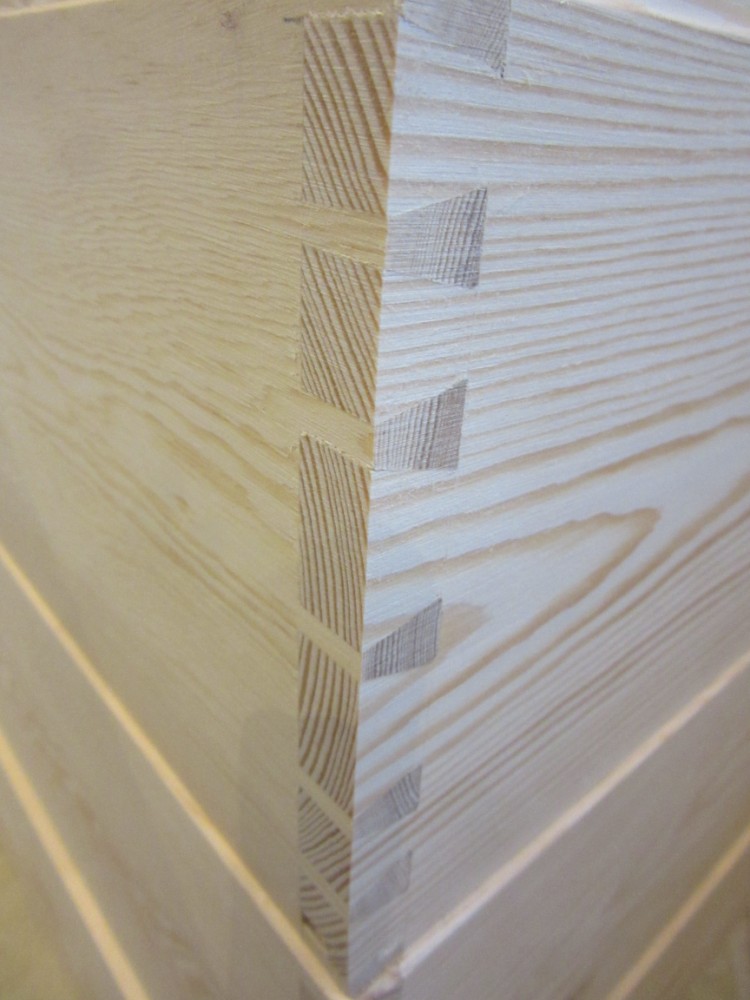It's been ages since I posted anything about making any woodwork, as I haven't been making anything for too long. (Custard knows that I am going to make a table and is being very patient waiting for me to start - I will make it before much longer, honest. ) But I've been asked to make a set of five wooden boxes and since they are not for me I have pulled my finger out and got on with it, rather quickly by my standards. I haven't finished yet but I thought I would share some of my ramblings so far and see if it's of any interest.
These need to match some shelving which is made of glued-up strips of softwood, so that takes care of the choice of material. Fortunately, our local excellent DIY shop sells "carpenter's pine" boards and not only do they charge about the same price as the big sheds, they will cut to size as well, at no extra cost. So I'm off to a flying start with 20 accurately and square cut pieces, exactly as ordered.

I have some leftover plywood to make the bottoms from. It's nominally 6mm, but skinny enough that a 6mm cutter makes a very sloppy fit. Fortunately I had a spare 1/4" cutter which I ground down to size on the bench grinder. Here it is in a Record 044C plough plane, with my comfy wooden replacement for the original blue plastic handle. Cutting the grooves is the first step. It defines the position of the end dovetail and it provides a really clear indication of which way up and which way round the pieces go.

As I'm using this cheap pine there are plenty of knots and resin pockets which can't be avoided. Sometimes I needed to do a bit of chiselling by hand to tame unruly grain, but on the whole the plough plane worked down through the rough bits nicely.


I do like to try out different ways of making things but I need this job to succeed, so I decided to stick with the method I know best and go for tails first. (The recent thread on tails or pins first convinced me I ought to try the other way, but not on this job.)
So here I am marking and cutting two sets of tails at the same time.


I wanted to fit the ply bottoms into grooves rather than rebates. I knew this could be done by cutting a mitre to cover the groove but couldn't find a good diagram of the joint. I half-remembered a website from someone called Geoff that I thought covered it and found this - dovetail construction - which was nearly what I wanted in diagram 1 - but was not quite right.
In writing this up for the forum I have now re-found Jeff Gorman's site which has a better diagram here in option D - which is what I managed to work out for myself, but it still took some careful thought when cutting it for the first time. (It's also very good at covering some of the details which others gloss over or avoid. A recommended read.)
This is what the tails look like. There's a straight down cut in line with the base of the groove, next to the last sloping cut.

The tails look like this:

It's really important not to make a vertical cut at the edge in the same way as for the tails - that line marks a cut which is at 45°, only visible on the inside of the groove.
I cut two sets of tails at the same time for two reasons. One is that it saves time by eliminating unnecessary marking - my only marks were on the front face of the front board of the pair. The back only needs a baseline, done with a cutting gauge. There's no point making marks you can't see when cutting.
The other reason is that it's easier to get the cuts square across the end if you make the end double thickness - on a single thin board it's harder to see errors.
Having done the saw cuts I needed to remove the waste.
For the first box, I did what I have done several times before and used my nice old treadle powered fretsaw. It's quite good for this and using it justifies the amount of floor space it takes up.


Having got fairly near the baseline I could pare away the rest without the usual problem that comes from soft pine, where great divots of wood come out like pulled teeth, leaving a rotten cavity covered by a pair of fragile veneers.
I did also take the precaution of using a proper old bevel edge chisel.

On the first two boxes I used my rather nice "Moxham style" vice that Douglas made me, which lets me work at a comfortable height and register the chisel on a broad guiding surface.
Transferring the marks to the other boards to mark out the pins was very traditional, using a plane on its side as a handy square support. There are two little extras which I think are worth mentioning - to help get things lined up, I put a handy offcut of suitable thickness into both grooves:

and I added an extra weight to keep the top board under control

That's it for now. The next installment will cover alternatives for marking and cutting and my thoughts on marking out to make clamping up easier.
These need to match some shelving which is made of glued-up strips of softwood, so that takes care of the choice of material. Fortunately, our local excellent DIY shop sells "carpenter's pine" boards and not only do they charge about the same price as the big sheds, they will cut to size as well, at no extra cost. So I'm off to a flying start with 20 accurately and square cut pieces, exactly as ordered.

I have some leftover plywood to make the bottoms from. It's nominally 6mm, but skinny enough that a 6mm cutter makes a very sloppy fit. Fortunately I had a spare 1/4" cutter which I ground down to size on the bench grinder. Here it is in a Record 044C plough plane, with my comfy wooden replacement for the original blue plastic handle. Cutting the grooves is the first step. It defines the position of the end dovetail and it provides a really clear indication of which way up and which way round the pieces go.

As I'm using this cheap pine there are plenty of knots and resin pockets which can't be avoided. Sometimes I needed to do a bit of chiselling by hand to tame unruly grain, but on the whole the plough plane worked down through the rough bits nicely.


I do like to try out different ways of making things but I need this job to succeed, so I decided to stick with the method I know best and go for tails first. (The recent thread on tails or pins first convinced me I ought to try the other way, but not on this job.)
So here I am marking and cutting two sets of tails at the same time.


I wanted to fit the ply bottoms into grooves rather than rebates. I knew this could be done by cutting a mitre to cover the groove but couldn't find a good diagram of the joint. I half-remembered a website from someone called Geoff that I thought covered it and found this - dovetail construction - which was nearly what I wanted in diagram 1 - but was not quite right.
In writing this up for the forum I have now re-found Jeff Gorman's site which has a better diagram here in option D - which is what I managed to work out for myself, but it still took some careful thought when cutting it for the first time. (It's also very good at covering some of the details which others gloss over or avoid. A recommended read.)
This is what the tails look like. There's a straight down cut in line with the base of the groove, next to the last sloping cut.

The tails look like this:

It's really important not to make a vertical cut at the edge in the same way as for the tails - that line marks a cut which is at 45°, only visible on the inside of the groove.
I cut two sets of tails at the same time for two reasons. One is that it saves time by eliminating unnecessary marking - my only marks were on the front face of the front board of the pair. The back only needs a baseline, done with a cutting gauge. There's no point making marks you can't see when cutting.
The other reason is that it's easier to get the cuts square across the end if you make the end double thickness - on a single thin board it's harder to see errors.
Having done the saw cuts I needed to remove the waste.
For the first box, I did what I have done several times before and used my nice old treadle powered fretsaw. It's quite good for this and using it justifies the amount of floor space it takes up.


Having got fairly near the baseline I could pare away the rest without the usual problem that comes from soft pine, where great divots of wood come out like pulled teeth, leaving a rotten cavity covered by a pair of fragile veneers.
I did also take the precaution of using a proper old bevel edge chisel.

On the first two boxes I used my rather nice "Moxham style" vice that Douglas made me, which lets me work at a comfortable height and register the chisel on a broad guiding surface.
Transferring the marks to the other boards to mark out the pins was very traditional, using a plane on its side as a handy square support. There are two little extras which I think are worth mentioning - to help get things lined up, I put a handy offcut of suitable thickness into both grooves:

and I added an extra weight to keep the top board under control

That's it for now. The next installment will cover alternatives for marking and cutting and my thoughts on marking out to make clamping up easier.


























